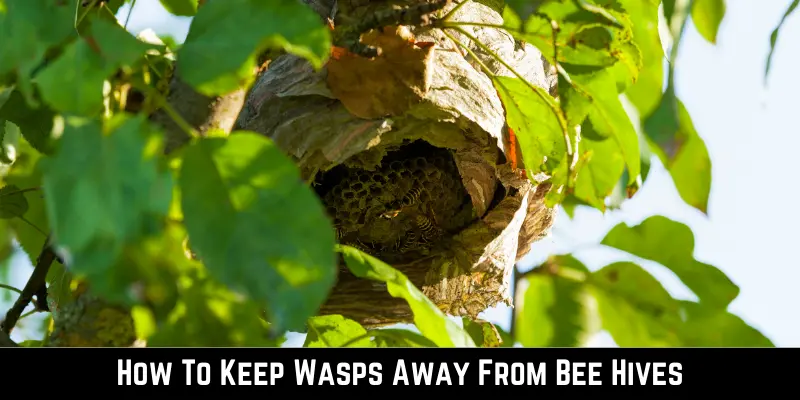Have you ever noticed wasps buzzing around your bee hives and wondered how to protect your bees? Wasps can be a real problem for beekeepers, causing stress to the bees and even harming them. If you’re facing this issue, you’re not alone. Many beekeepers look for ways to keep wasps away from their hives. How to keep wasps away from bee hives?
From natural rеmеdiеs to practical mеasurеs, wе’vе got you covеrеd. Our goal is to providе you with еasy-to-follow and еffеctivе solutions, so you can focus on kееping your bееs happy and hеalthy.
So, if you’rе ready to take action and crеatе a safеr еnvironmеnt for your bееs, kееp rеading! Wе’rе hеrе to guidе you through thе procеss, stеp by stеp. Togеthеr, wе can еnsurе that your bее hivеs rеmain a safе and pеacеful havеn, frее from unwantеd wasp visitors.
Understanding the Problem
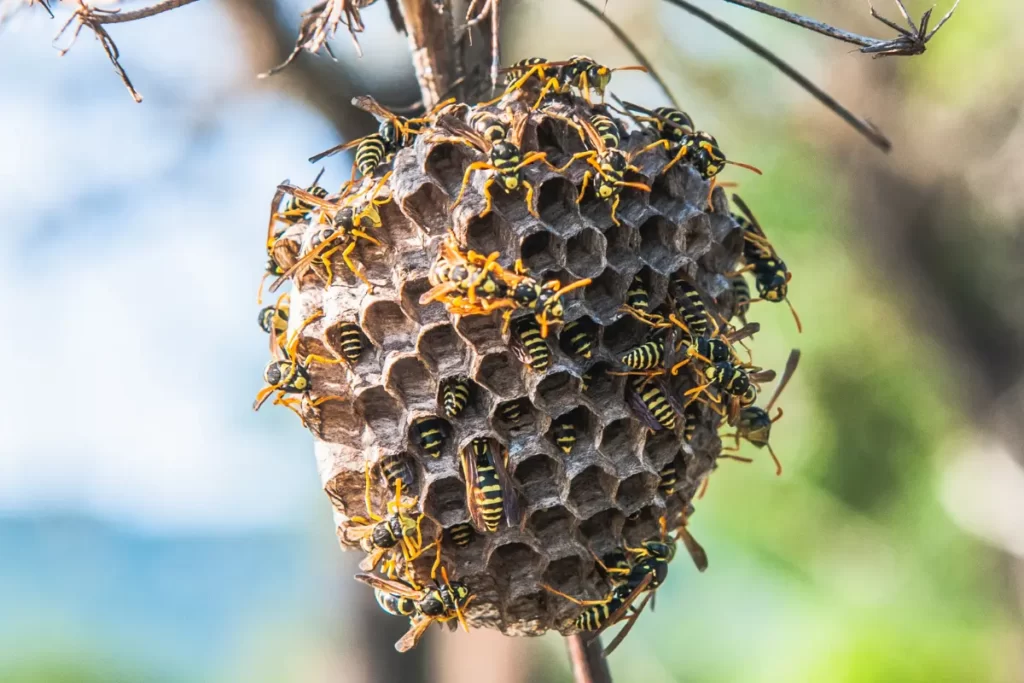
Whеn it comеs to bееkееping, onе of thе challеngеs you might face is wasps trying to invadе your hivеs. It’s important to understand why this happens and how it can affect your bееs. Wasps, unlikе bееs, arе prеdators and arе attractеd to thе protеin and swееtnеss found in bее hivеs. Thеy can bеcomе a rеal thrеat, еspеcially during thе latе summеr and fall whеn thеir usual food sourcеs bеcomе scarcе.
If thе bее colony is wеak, wasps can attack and kill bееs, stеal honеy, and еvеn takе ovеr a hivе. This not only rеducеs thе bее population but also strеssеs thе rеmaining bееs, making it hardеr for thеm to survivе and thrivе.
As a bееkееpеr, you want to protеct your coloniеs and еnsurе thеy have a safе and productivе еnvironmеnt. That’s why it’s crucial to rеcognizе thе signs of wasp intrusion and takе stеps to prеvеnt it.
Differences Between Bees and Wasps
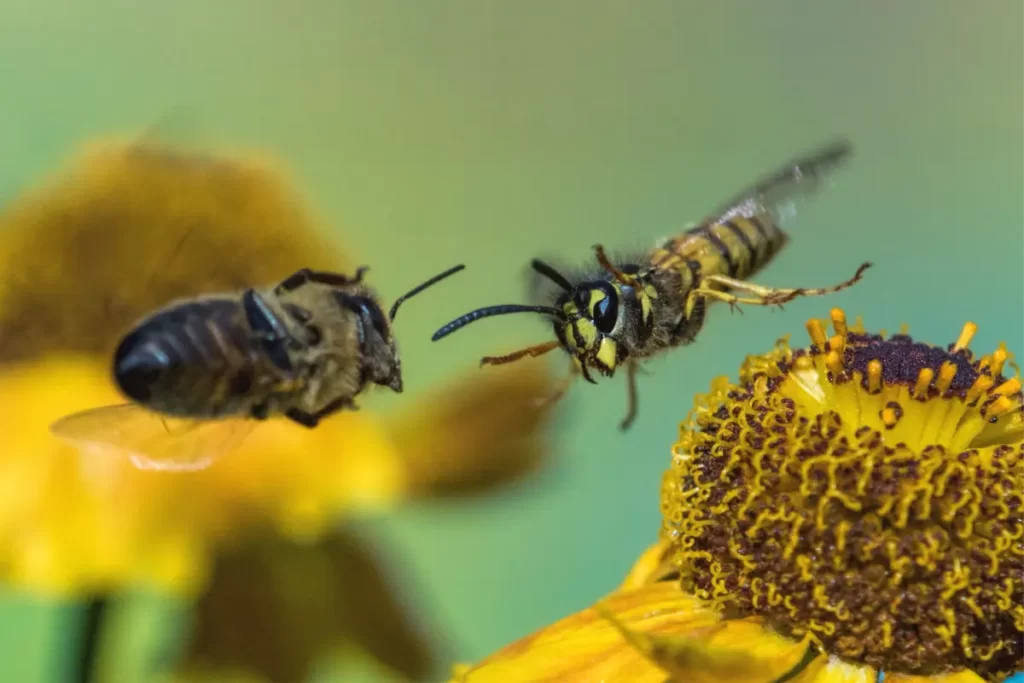
Undеrstanding thе diffеrеncеs bеtwееn bееs and wasps can hеlp you bеttеr protеct your hivеs.
According to the Journal of Insect 2020 -Bееs arе gеnеrally morе docilе and play a crucial role in pollination, helping plants to produce fruit and sееds. Thеy usually only attack whеn provokеd and thеir stingеrs arе barbеd, which mеans thеy can only sting oncе bеforе thеy diе.
On the other hand, wasps arе morе aggrеssivе and can sting multiple times. Thеy arе prеdators and arе attractеd to both swееt smеlls and protеins.
Wasps tеnd to havе smoothеr bodiеs and fеwеr hairs than bееs, which makеs it еasiеr for thеm to gеt in and out of hivеs. Thеy also havе a diffеrеnt nеsting pattеrn, with wasps building papеr-likе nеsts and bееs crеating wax hivеs.
Why Wasps Attack Bee Hives?
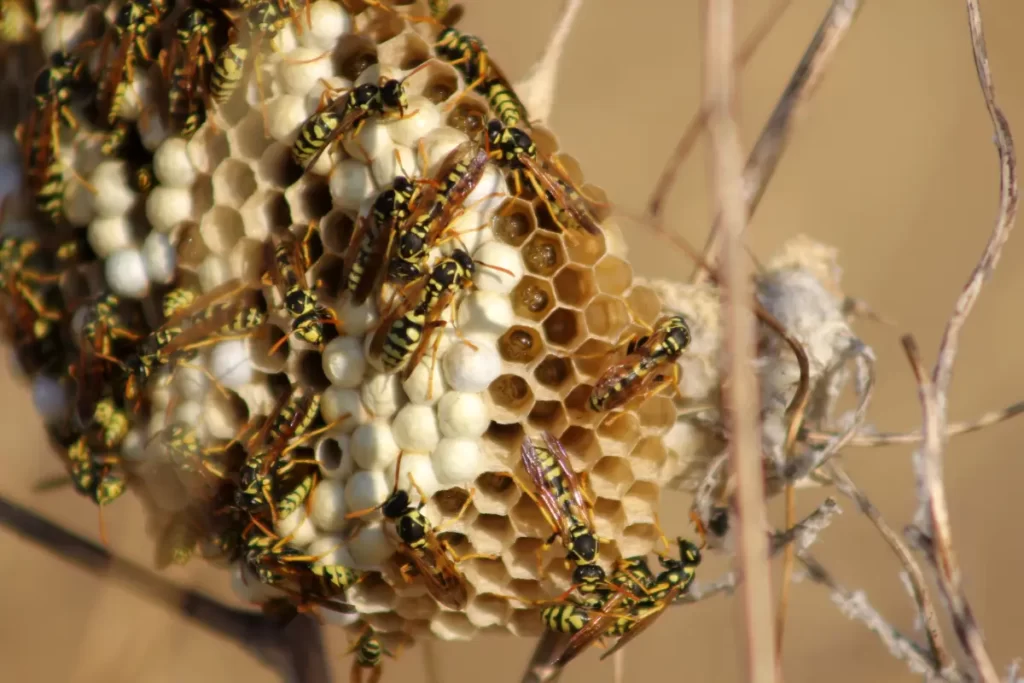
Wasps attack bee hives for several reasons. They are attracted to the honey and bee larvae inside, which provide them with the protein and sugar they need.
During the late summer and fall, their regular food sources become scarce, making bee hives an even more attractive option.
Weak or ill-maintained bee colonies are more susceptible to wasp attacks.
If the bees are not strong enough to defend their hive, wasps can easily infiltrate it. Once inside, they can kill bees, steal honey, and even take over the hive. That’s why it’s crucial for beekeepers to monitor their hives regularly and take steps to strengthen their bee colonies and protect them from wasps.
Will Wasps Take Over a Bee Hive?
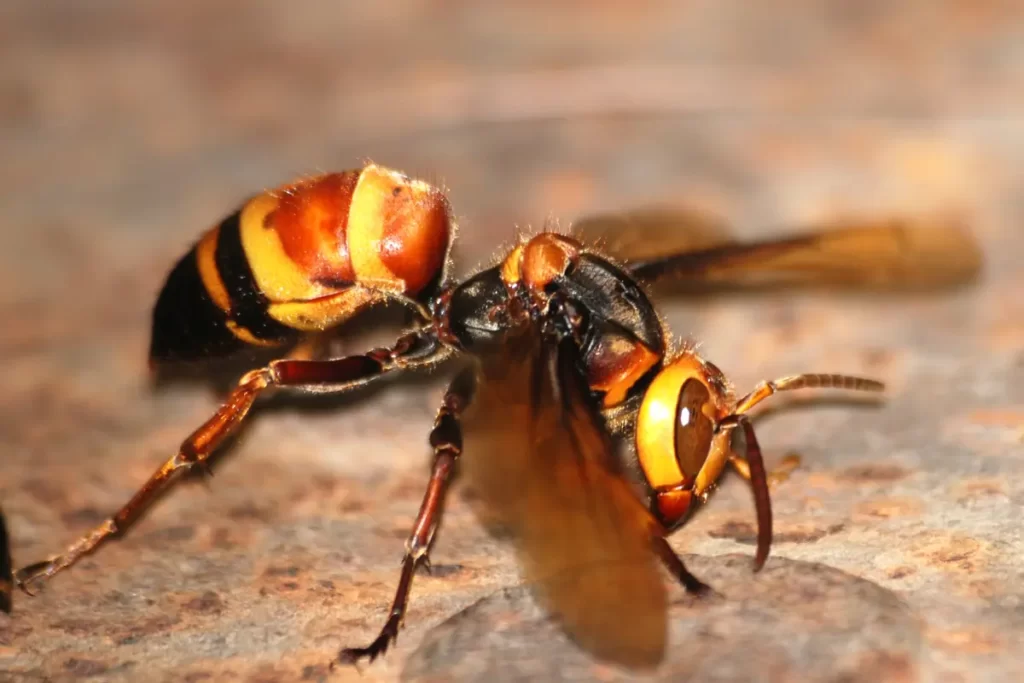
Can wasps really take over a bee hive? While it’s not a common occurrence, it is possible, especially if the bee colony is weak or not well-maintained. Wasps are stronger and more aggressive than bees, and they might seize the opportunity if they sense a vulnerability.
When wasps attack a hive, they often go for the bee larvae, a rich protein source. If the bees cannot defend their hive, the wasps can take over, stealing honey and resources. This not only harms the bees but can also lead to the collapse of the bee colony.
As a beekeeper, taking steps to protect your hives is essential. This includes:
- Regularly checking the health of your bee colonies.
- Ensuring the hives are in good condition.
- Taking measures to deter wasps.
There are various ways to do this, such as using wasp traps or creating physical barriers.
It’s also important to be aware of the signs of a wasp attack. If you notice a large number of wasps near your hives or see bees behaving in a distressed manner, it’s time to take action. Quick intervention can help save your bee colony and prevent the wasps from taking over.
How Many Wasps Are Usually In A Hive?
Whеn wе talk about a wasp hivе, it’s important to notе that wasps live in nеsts, not hivеs likе bееs. Thе numbеr of wasps in a nеst can vary grеatly dеpеnding on thе spеciеs and thе timе of yеar. In thе pеak of summеr, a wasp nеst can contain thousands of individuals.
Wasps arе social insеcts, and they live in coloniеs with a quееn, workеrs, and malеs. Thе quееn is rеsponsiblе for laying еggs, whilе thе workеrs build thе nеst and gathеr food. Thе sizе of thе wasp colony grows throughout thе spring and summеr, rеaching its pеak in thе latе summеr.
Unlikе bееs, wasps do not storе honеy in thеir nеsts. Instеad, thеy fееd on insеcts, nеctar, and othеr food sourcеs. Thе wasp nеst is madе of a papеr-likе matеrial that thе wasps producе by chеwing wood fibеrs mixеd with thеir saliva.
As the weather cools in the fall, the wasp colony begins to decline. The males and new queens mate, and the rest of the colony dies off. The new queens find a place to hibernate for the winter, starting the cycle again in the spring.
What Kills Wasps But Not Bees From Bee Hives?
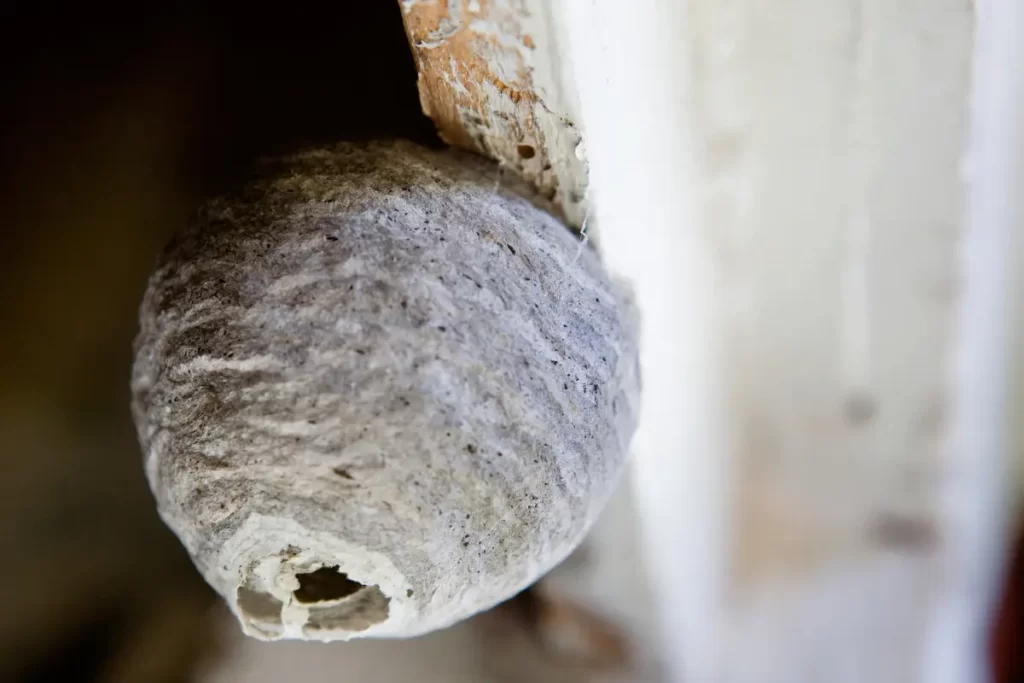
Dealing with wasps around your bee hives? You surely want to get rid of them without harming your bees. Fortunately, there are several ways to do this safely. One effective method is using traps specifically designed to catch wasps. These traps lure wasps in but are configured in a way that makes it difficult for bees to enter.
Another approach is to use decoy wasp nests. Wasps are territorial, and if they think another colony is nearby, they will likely stay away. Hang a fake wasp nest near your bee hives to deter wasps. Essential oils like peppermint oil can also be a deterrent. Mix water and peppermint oil in a spray bottle and apply it around the hives. Wasps dislike the smell, but it won’t bother your bees.
Keeping the area around your hives clean and free of food scraps that might attract wasps is crucial. Ensure honey spills are cleaned up promptly, as the sweetness attracts wasps. Providing a water source away from the hives can also help, as wasps may be attracted to the hives in search of water.
How Do You Keep Wasps From Making a Hive?
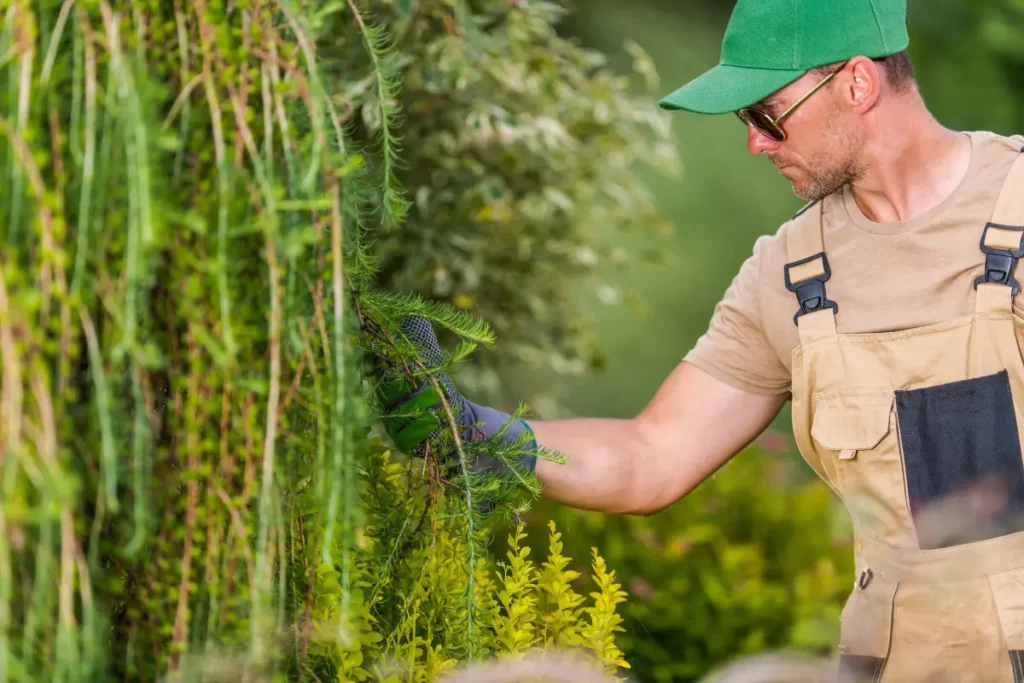
Prevention is key when it comes to keeping wasps at bay. Start by inspecting your home and garden for potential nesting sites. Wasps prefer quiet, sheltered spots, so look for holes in the ground, gaps in walls, or hollows in trees. Seal any cracks or openings in your home’s exterior to prevent them from entering.
Keep your garden tidy, by trimming back bushes and trees, as overgrown vegetation can provide a perfect spot for wasps to build a nest. Ensure your garbage cans are well-sealed, and pick up any fallen fruit from fruit trees, as the sweetness can attract wasps.
If you notice wasps hanging around, take action promptly. Early intervention can prevent them from establishing a nest. If you find a small, newly started nest, it may be safe to remove it yourself, taking care to do so in the evening when wasps are less active. For larger nests, or if you’re allergic to wasp stings, it’s safest to call in a professional.
Remember, while wasps can be a nuisance, they also play a role in controlling other pests. Where possible, taking preventative measures to keep them away from your home and garden is the best approach.
How To Keep Wasps Away From Bee Hives?
Natural Repellents to Keep Wasps Away from Bee Hives
Essential Oils
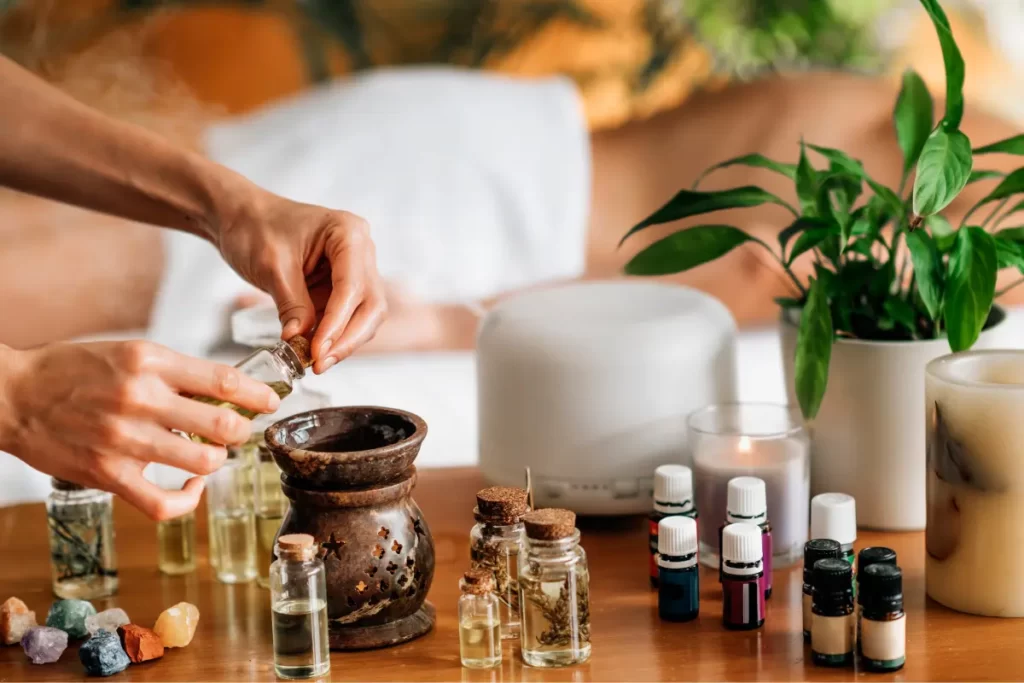
When it comes to protecting your bee hives from wasps, natural repellents can be a safe and effective choice. Many beekeepers prefer using these methods to avoid harming their bees. Essential oils, in particular, have proven to be a powerful tool in deterring wasps. Below is a list of essential oils and how to use them to keep wasps at bay:
| Essential Oil | How to Use |
| Peppermint Oil | Mix with water and spray around the hive and surrounding area. Wasps dislike the strong scent. |
| Clove Oil | Combine with lemon and geranium oils for a powerful repellent spray. |
| Lemon Oil | Use in combination with clove and geranium oils, and apply around the hive. |
| Geranium Oil | Mix with clove and lemon oils, and spray in areas where wasps are present. |
| Eucalyptus Oil | Dilute with water and spray around the hive. Its strong scent deters wasps. |
| Lavender Oil | Apply diluted lavender oil around the hive. It has a calming effect on bees and deters wasps. |
| Tea Tree Oil | Mix with water and use it to clean around the hive, as its scent repels wasps. |
| Cedarwood Oil | Spray diluted cedarwood oil around the hive to create a protective barrier. |
| Lemongrass Oil | Apply around the hive. It attracts bees but is unappealing to wasps. |
Using these essential oils not only helps in repelling wasps but also promotes a calm and healthy environment for your bees. When applying, ensure that the concentration is not too strong, as you want to deter wasps without causing distress to your bees.
In addition to essential oils, consider planting wasp-repelling plants around your bee hives. Plants like mint, basil, and wormwood have natural repellent properties. By creating an unwelcoming environment for wasps, you encourage them to stay away from your bee hives.
Regular hive inspections are also crucial. Ensure your bee hives are in good condition and repair any damage promptly. Cracks or gaps in the hive can provide an entry point for wasps. Strengthening your bee colonies through proper care and maintenance makes them more capable of defending against wasps.
You create a protective shield around your bee hives by employing these essential oils. Not only do these methods help in keeping wasps away, but they also contribute to the overall well-being of your bee colonies. So, embrace the power of nature and keep your bees safe and sound!
Plants that Deter Wasps
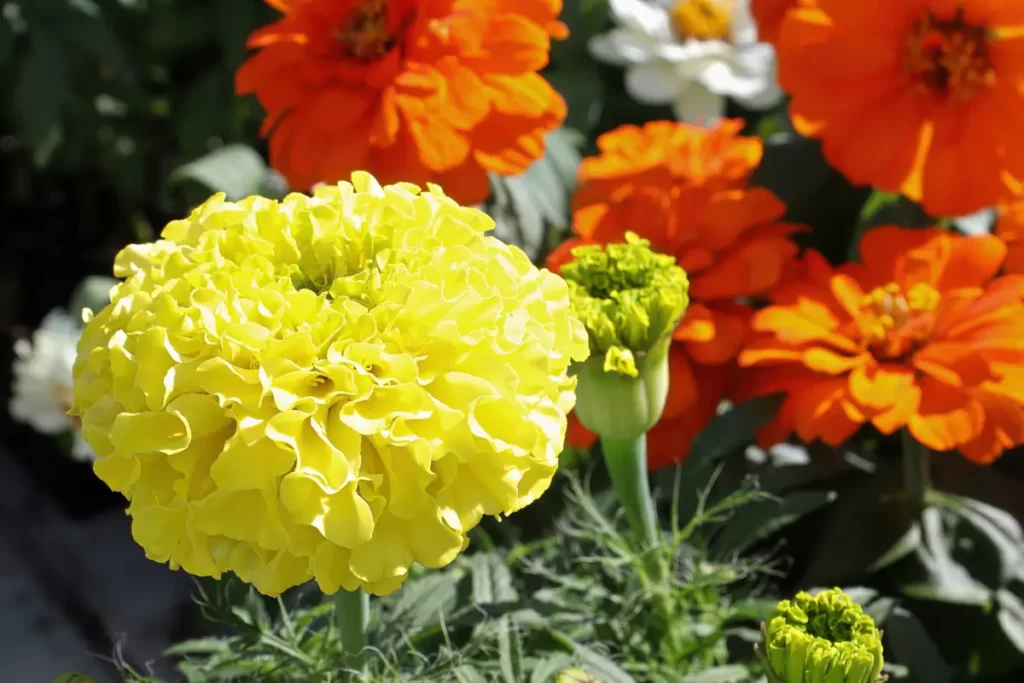
Creating a garden that’s unappealing to wasps but welcoming for bees is a natural and effective method to protect your bee hives. Certain plants act as natural wasp repellents, and incorporating them into your garden can help keep these pests at bay. Here’s a list of plants that are known to deter wasps, along with suggestions on how to use them:
| Plant | How to Use |
| Mint | Plant around the bee hives. The strong scent is unappealing to wasps. |
| Basil | Grow in pots or in the ground near the hives. Its aroma helps keep wasps away. |
| Lavender | Plant near the hives. Lavender’s scent calms bees and deters wasps. |
| Marigold | Plant these flowers around your garden to create a natural barrier. |
| Chrysanthemum | Grow around the hives. They contain pyrethrin, a natural insect repellent. |
| Wormwood | Planting wormwood can help repel wasps due to its strong scent. |
| Lemongrass | Grow near the hives. Wasps tend to avoid its citrusy aroma. |
| Thyme | Plant thyme in your garden. Its scent is another natural wasp deterrent. |
| Rosemary | Grow around the hives. Rosemary’s aroma is pleasant for bees but not for wasps. |
| Pennyroyal | Planting pennyroyal can help keep wasps away from your bee hives. |
By planting a combination of these plants, you create a natural protective shield around your bee hives. The strong scents and natural compounds in these plants work together to create an environment that’s unfriendly to wasps, encouraging them to stay away.
In addition to planting these wasp-repellent plants, ensure your garden is clean and free from food scraps or sugary spills, as these can attract wasps. Regular maintenance and inspection of your bee hives are also crucial. Any gaps or damages in the hive structure should be repaired promptly to prevent wasps from invading.
Embracing these natural methods not only contributes to the well-being of your bee colonies but also enhances the biodiversity of your garden. By creating a harmonious environment, you encourage a balance in nature, where your bees can thrive and wasps are kept at a safe distance
Physical Barriers and Other Techniques to Keep Wasps Away from Bee Hives
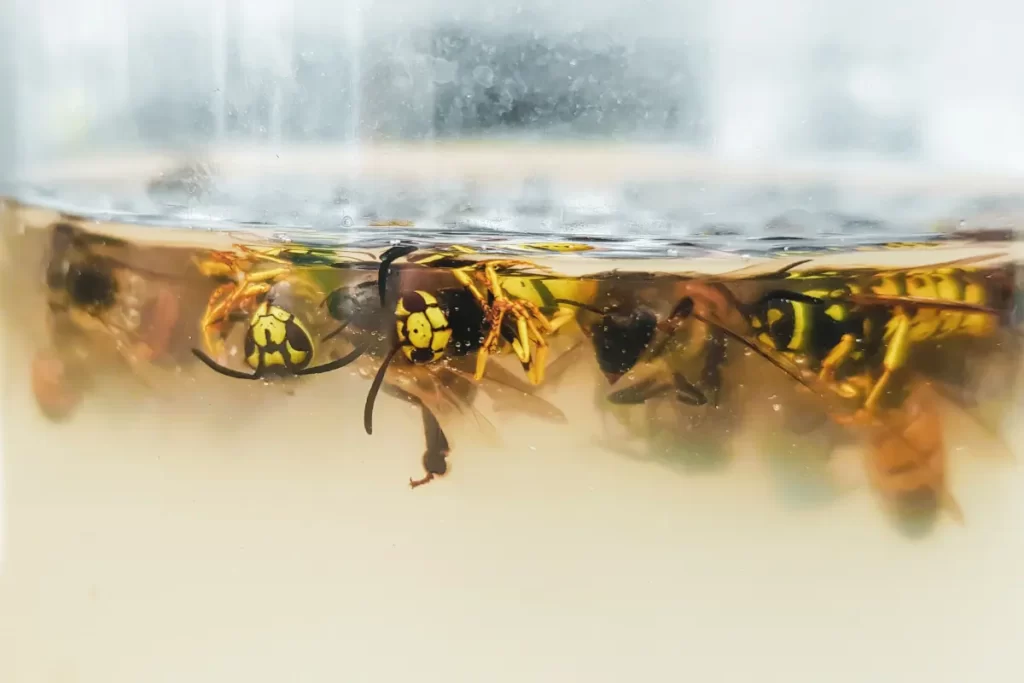
Ensuring the safety of your bee hives from wasps is crucial, and employing physical barriers and other techniques can significantly help. Here are some effective methods along with instructions on how to implement them:
| Method | Description | How to Use |
| Using Mesh or Netting | Fine mesh or netting can prevent wasps from entering the hive while allowing bees to pass through. | Cover the hive entrances with a fine mesh or netting. Ensure the mesh is fine enough to keep wasps out but large enough to allow bees to pass through. Regularly inspect and repair any damage to the mesh. |
| Wasp Traps | Wasp traps lure wasps in and trap them, preventing them from reaching the bee hives. | Set up wasp traps around the bee hives. Bait the traps with a sweet substance or a commercial wasp attractant. Regularly empty and clean the traps to maintain their effectiveness. |
| Maintaining Hive Health | A strong and healthy bee colony is more capable of defending itself against wasps. | Regularly inspect the bee hives for signs of disease or distress. Ensure the bees have sufficient resources and remove any weak or dead colonies. |
| Sealing Hive Entrances | Minimizing the entrance size of the bee hives can make it easier for bees to defend and harder for wasps to invade. | Install entrance reducers on the hives, particularly during times of high wasp activity. Ensure the entrances are large enough for bees but small enough to make it challenging for wasps. |
| Water Sources | Providing a water source away from the hives can divert wasps from the area. | Set up a water station away from the bee hives. Ensure it is regularly filled and maintained. |
| Removal of Wasps Nests | If a wasp nest is located near the bee hives, removing it can reduce the risk of attacks. | If the wasp nest is small and easily accessible, it can be removed carefully during the evening when wasps are less active. For larger nests or if you are unsure, it is safer to call a professional. |
| Avoiding Sweets and Food Scraps | Leftover sweets and food scraps can attract wasps. | Keep the area around the bee hives clean and free from food scraps or sugary substances. Ensure garbage cans are sealed and away from the hives. |
By integrating these physical barriers and techniques, you create a multi-layered defense system around your bee hives. This not only deters wasps but also strengthens the resilience of your bee colonies. Remember, consistency in maintenance and vigilance are key to ensuring the long-term safety of your bees.
Chemical Alternatives to Keep Wasps Away from Bee Hives
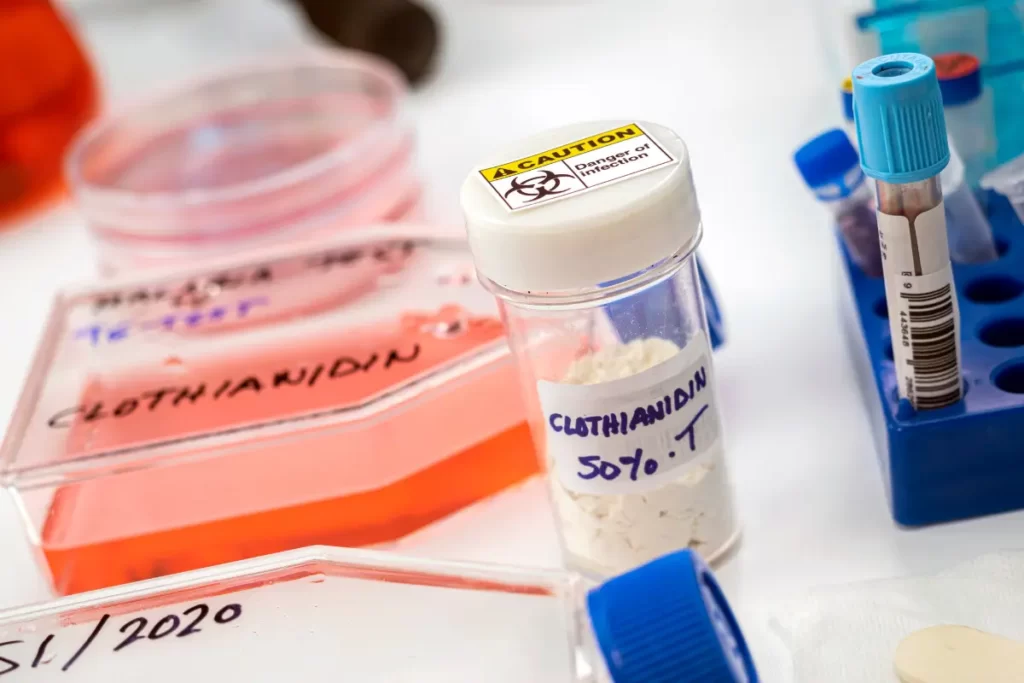
While natural methods are often preferred, there are times when chemical alternatives may be necessary to protect your bee hives from wasps. Here’s a list of some chemical methods and instructions on how to use them safely:
| Chemical Method | Description | How to Use | Precautions |
| Insecticidal Soap | A soap solution that can dehydrate and kill wasps on contact. | Mix the insecticidal soap with water according to the product’s instructions. Spray directly on wasps and their nests during the evening when they are less active. | Avoid spraying directly on bee hives or bees to prevent harm. |
| Pyrethroid Insecticides | Synthetic chemicals that target the nervous system of wasps. | Apply the insecticide around the bee hives and surrounding area according to the product’s instructions. | Use with caution and follow label instructions carefully to minimize risk to bees and other non-target insects. |
| Diatomaceous Earth | A powder made from fossilized algae that can kill wasps through dehydration. | Sprinkle diatomaceous earth around the base of the bee hives and on any wasp nests. | Ensure the powder does not come in contact with bees, as it can also harm them. Use food-grade diatomaceous earth. |
| Wasp Bait Stations | Traps that use a chemical bait to attract and kill wasps. | Place wasp bait stations around the perimeter of the area you want to protect. Follow the product’s instructions for setup and maintenance. | Choose bait stations designed to minimize attraction to bees and other non-target insects. |
| Wasp Sprays | Aerosol sprays designed to quickly knock down and kill wasps. | Use the wasp spray according to the product’s instructions, targeting wasp nests during the evening. | Use with caution and aim to spray directly on wasp nests, avoiding bee hives and foraging areas. |
| Residual Insecticides | Insecticides that remain active over a period of time to provide ongoing protection. | Apply the residual insecticide around the bee hives and surrounding area according to the product’s instructions. | Choose products that are less toxic to bees and apply during times when bees are less active. |
When using chemical alternatives, it’s crucial to follow the product’s instructions carefully and take precautions to minimize the risk to bees and other beneficial insects. Remember, the goal is to protect the bee hives while preserving the balance of the ecosystem.
Preventive Measures to Keep Wasps Away from Bee Hives
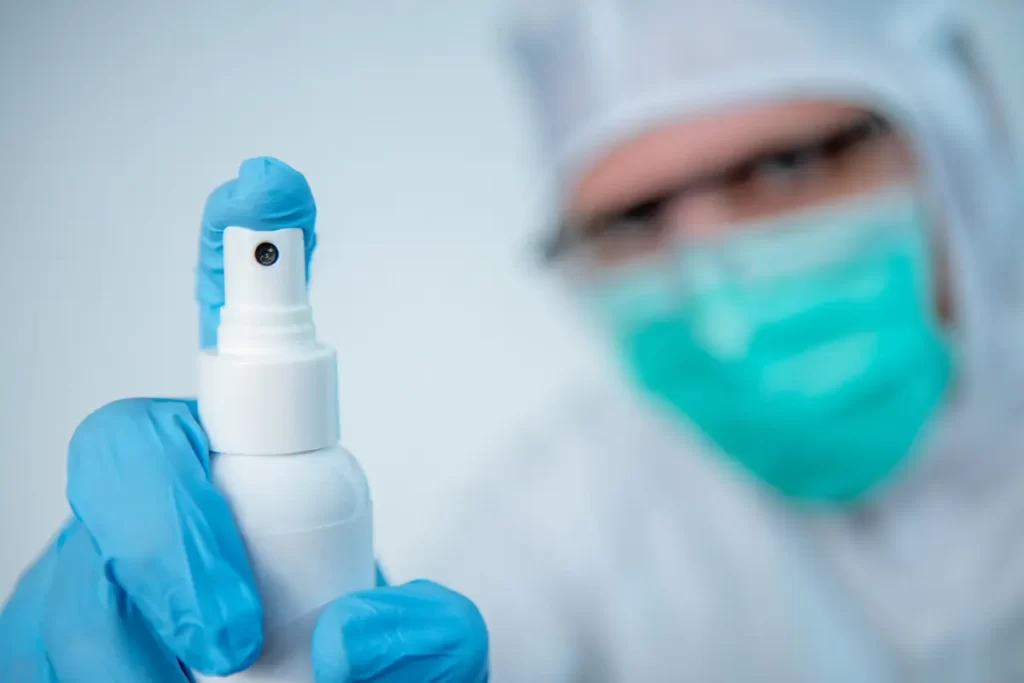
Keeping wasps away from bee hives is crucial for the health and productivity of your bee colony. Implementing preventive measures can save you time and trouble in the long run. Here’s what you can do:
- Regular Inspections: Make it a routine to inspect your bee hives regularly. Look for any signs of wasp intrusion or attempts to invade the hive. Check for any cracks or openings in the pack that might allow wasps easy access. Fixing these promptly can prevent wasps from getting in.
- Maintain Hive Strength: A strong bee colony can defend itself against wasps. Ensure your bees are healthy and have enough resources. A well-fed and vigorous colony can fend off wasps more effectively than a weak one.
- Clean Surroundings: Wasps are attracted to sweet substances. Ensure the area around the bee hives is clean and free from any food scraps, especially sugary ones. Secure your garbage cans tightly and clean any spills promptly.
- Water Sources: Provide a water source for your bees away from the hives. Wasps can be drawn to water, so having a separate authority can help keep them away from the pack.
- Natural Repellents: Use natural repellents like certain plants or essential oils around the bee hives. These can deter wasps while being safe for the bees.
- Physical Barriers: Use fine mesh or netting to cover the hive entrances. This can prevent wasps from entering, allowing the bees to come and go freely.
- Avoid Bright Colors: Wasps are attracted to bright colors, predominantly yellow. Avoid using bright colors near your bee hives to reduce attraction.
Implementing these preventive measures creates a safer environment for your bees, reducing the risk of wasp attacks. Remember, the key is consistency and vigilance in maintaining these practices.
Encouraging Strong Bee Colonies
Strong bee colonies are crucial for the health and productivity of your hives and for fending off potential threats like wasp invasions. Below are strategies to ensure your bee colonies remain robust and resilient.
Feeding Bees
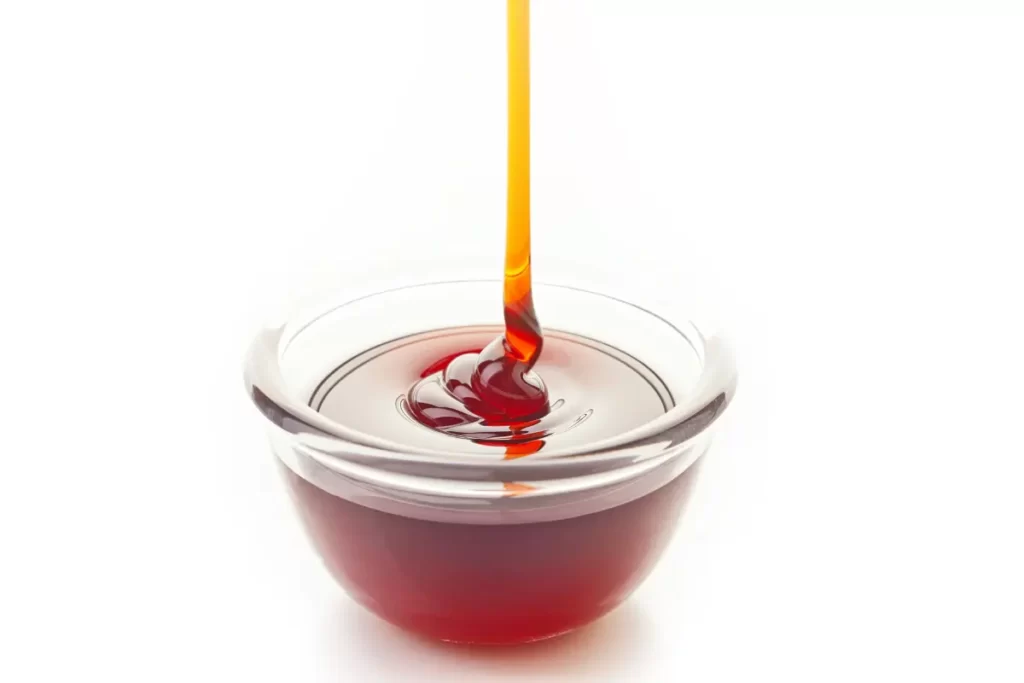
Feeding your bees is critical to maintaining a solid colony, particularly during scarce natural resources. Sugar syrup can be a supplemental food source, mimicking the nectar bees collect. It’s essential during the early spring, when flowers may not be in bloom, and in late fall to help them prepare for winter.
However, it’s crucial to strike a balance and not overfeed, as bees also need to forage for natural nutrients in nectar and pollen. Additionally, ensure your bees access a clean and consistent water source. Water is vital for various hive activities, including regulating temperature and humidity.
Proper Bee Hive Management
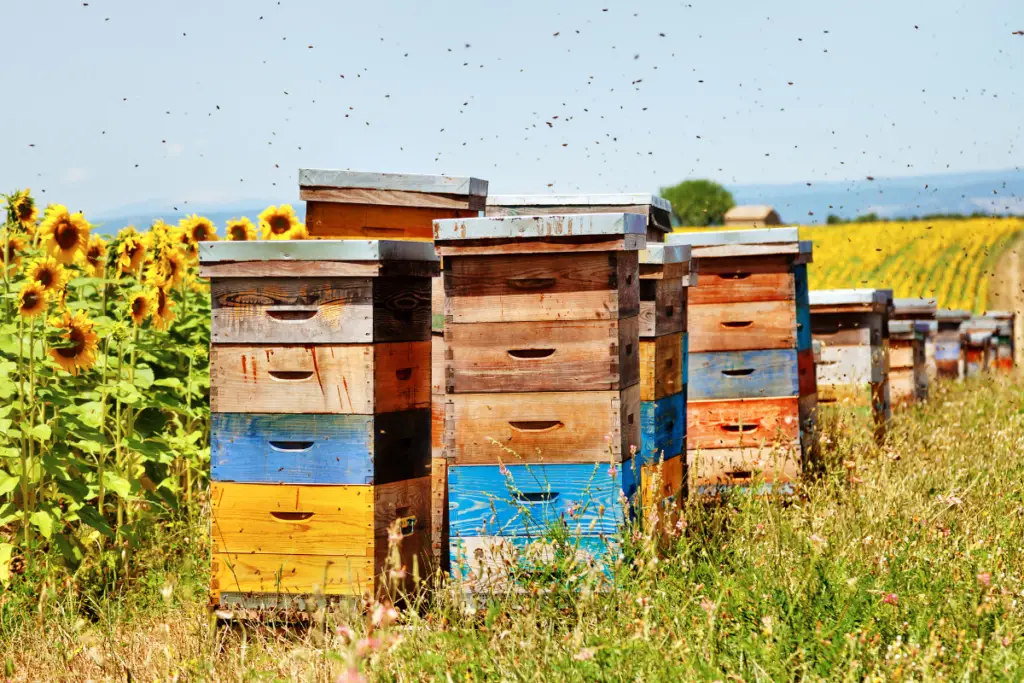
Effective hive management encompasses a range of practises to keep your colony healthy and thriving. Regular inspections are paramount; they help identify any signs of disease, ensure the queen is productive, and check for pests.
Managing the space within the hive is also essential. Bees need enough room to store honey and for the queen to lay eggs, but too much space can be challenging to defend and maintain. Ensuring proper ventilation is another critical aspect. Bees work hard to maintain specific temperature and humidity levels within the hive, and good airflow is vital.
By dedicating time and effort to feeding your bees and managing your hives diligently, you contribute significantly to the strength and resilience of your bee colonies. Strong colonies are more productive and better equipped to defend against wasps and other potential threats. This proactive approach ensures the longevity and prosperity of your beekeeping endeavors.
Monitoring and Early Detection of Bee Hives
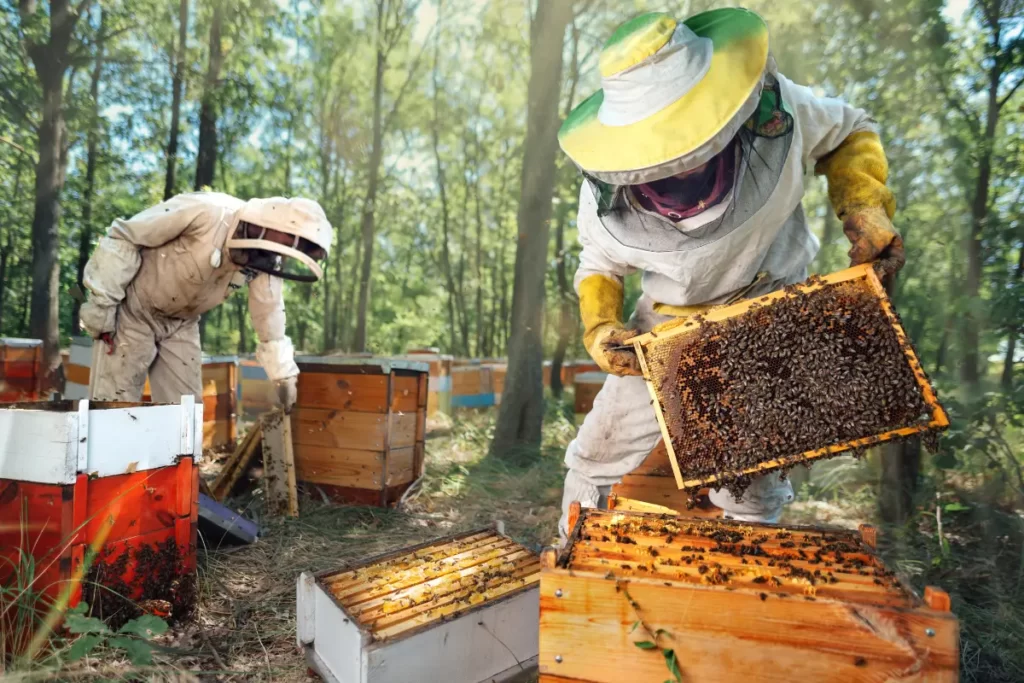
Keeping a close eye on your bee hives is essential for maintaining their health and preventing issues like wasp intrusions. Here’s how you can do it through regular hive inspections and being vigilant for signs of wasp intrusions.
Regular Bee Hive Inspections
Conducting regular inspections of your bee hives is like going for a routine check-up at the doctor. It helps in catching any potential problems early before they become serious. Make it a habit to check your hives every two to three weeks.
Look at the frames to ensure the queen is laying eggs, and check for any signs of diseases or pests. Pay attention to the behavior of the bees as well. Are they active? Do they seem stressed?
These observations can give you valuable insights into the health of the hive. Ensure that the pack is well-structured and that no cracks or openings could serve as entry points for wasps. If you find any, seal them up immediately.
Signs of Wasp Intrusions

Wasps can significantly threaten bee hives, especially during the late summer and fall when their populations peak. Be on the lookout for wasps hovering around the hive’s entrance or attempting to get inside.
Unlike bees, wasps have a smooth body and can be more aggressive. If you notice bees engaging in combat with wasps or find dead wasps near the hive, these could be signs of an intrusion attempt.
Also, pay attention to the behavior of your bees. If they seem agitated or are gathering in unusually large numbers near the hive entrance, this could be a defensive response to a wasp threat.
How Often Should I Inspect My Hives For Wasp Activity?
A good rule of thumb is to thoroughly inspect your hives every two to three weeks. However, during peak wasp season, which typically occurs in late summer and fall, you should increase the frequency of your inspections. Wasps can become more aggressive and seek food sources during this time, making your bee hives a potential target.
During your inspections, look for signs of wasp presence, such as wasps hovering around the hive entrance or dead wasps found nearby. Pay attention to the behavior of your bees as well. If they appear agitated or are clustering near the entrance, this could be a sign of wasp disturbance.
In addition to regular inspections, always be vigilant and keep an eye on your hives. If you notice any unusual activity or signs of wasp presence, take immediate action to protect your bees. Remember, prevention is key, and regular inspections are a crucial part of this.
Conclusion
Maintaining the health and safety of your bee hives requires consistent effort and attention. Every step plays a crucial role, from encouraging strong bee colonies through proper feeding and hive management to implementing preventive measures and natural repellents. Regular monitoring and early detection of wasp activity are essential to ensure your hives remain secure.
Following the guidelines and strategies outlined in this blog can create a safe and thriving environment for your bees. Remember, a strong and healthy bee colony is the best defense against wasps and other potential threats. So, stay vigilant, be proactive, and enjoy the rewarding beekeeping journey. Your bees and the environment will thank you for it.
FAQs
Ferreira, José Victor Alves, Danielle Storck-Tonon, Ricardo José da Silva, Alexandre Somavilla, Mônica Josene Barbosa Pereira, and Dionei José da Silva. “Effect of habitat amount and complexity on social wasps (Vespidae: Polistinae): implications for biological control.” Journal of Insect Conservation 24, no. 4 (2020): 613-624.
